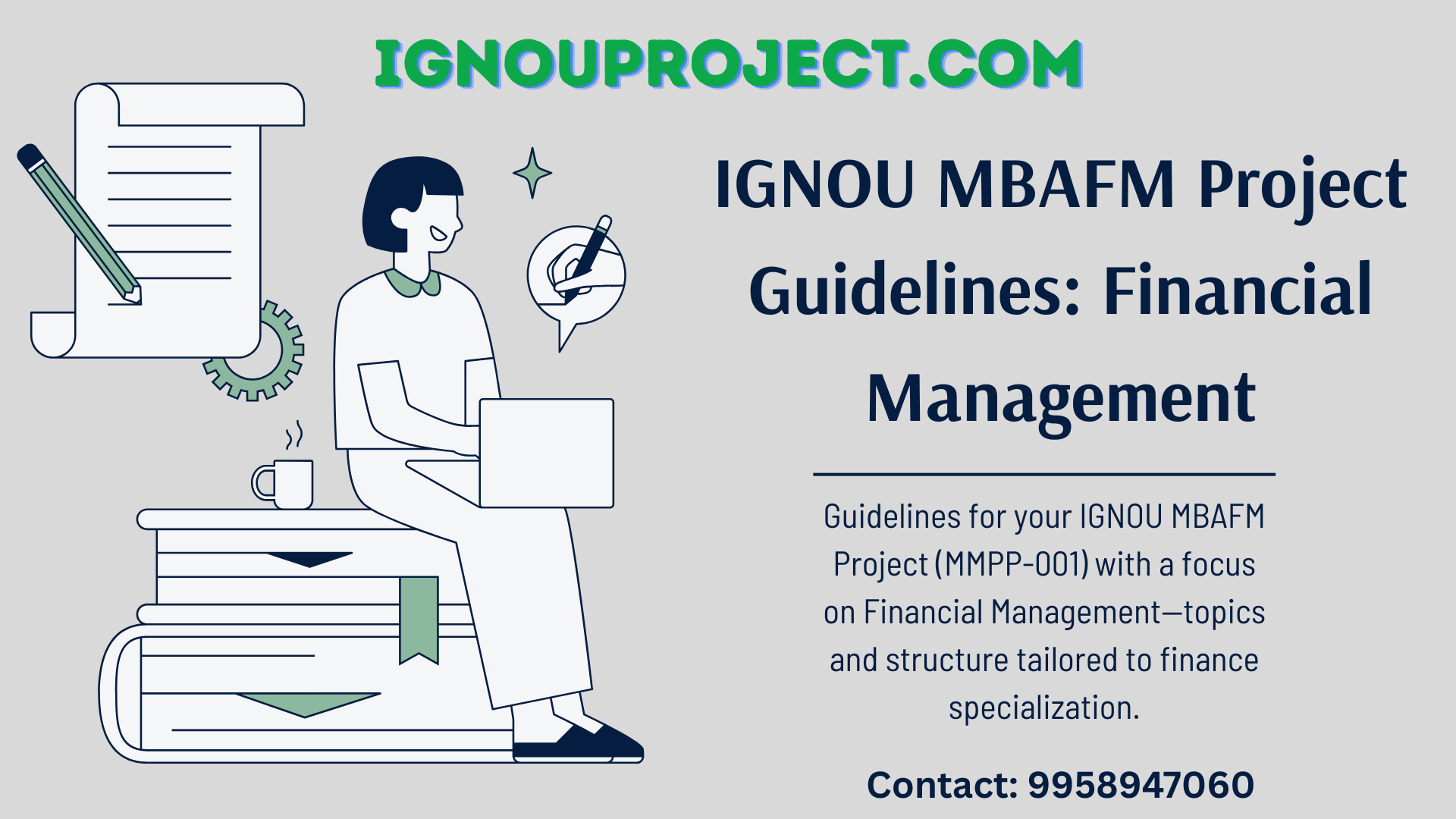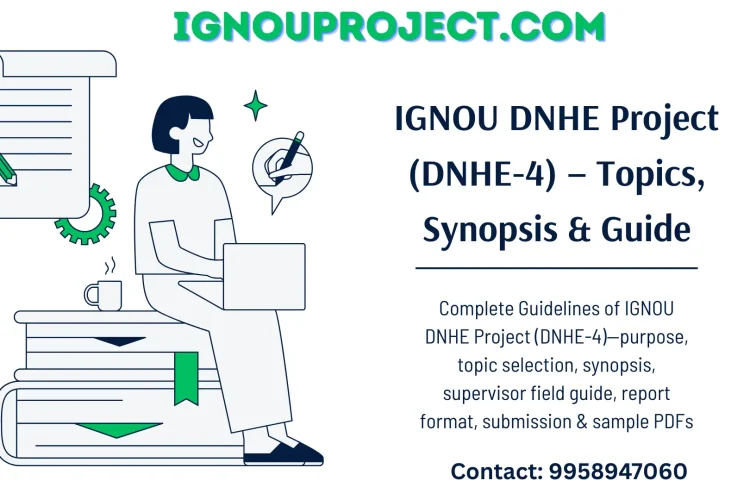
The IGNOU MBAFM Project in Financial Management is a capstone requirement for the MBA (Financial Management) specialization. The project course, MMPP-001 for MBAFM, is an 8-credit program typically taken in Semester 3. In this project, students select a finance-related problem and apply classroom theories and tools to solve it.
IGNOU’s MBAFM specialization prepares graduates for leadership roles in corporate finance, investment analysis, financial consulting, and planning. Thus, the project is designed to develop practical skills by bridging theory with real-world financial issues.
📊 Key Highlights:
- Course Details: MMPP-001 (MBAFM) – an 8-credit project course in IGNOU’s MBA (Financial Management) curriculum.
- Specialization Focus: MBAFM prepares students in budgeting, cost management, financial modeling, and strategic planning.
- Project Purpose: The project helps learners develop an ability to apply multidisciplinary concepts, tools, and techniques to organizational finance problems. It allows students to apply theoretical knowledge in practice, honing analytical and decision-making skills.
Objectives of the IGNOU MBAFM Project
The main objectives of an IGNOU MBAFM project are educational and practical. Key goals include:
- Real-World Problem Solving: Tackle actual finance problems within organizations (e.g., optimizing capital structure or improving investment returns).
- Application of Theory: Use financial models (like NPV, IRR, CAPM) and theories (e.g., risk-return tradeoff) in context.
- Analytical Skill Development: Perform data analysis (such as financial ratio computation) to support conclusions.
- Decision-Making and Communication: Formulate informed recommendations and present them clearly.
Overall, the project “enables the practical application of theoretical knowledge” and builds problem-solving ability, preparing you for finance roles like those IGNOU describes (corporate finance, investment analysis, etc.
Choosing a Finance-Specific Topic for MBAFM Project
Selecting the right finance topic is crucial. It should be specific, feasible, and aligned with MBAFM. Choose an issue that interests you and has data available. Topics often fall into these categories:
Sample topics in areas like:
- 📈 Investment Analysis:
- Portfolio performance analysis of mutual funds
- Investors’ preference between stocks and bonds
- Evaluation of an equity issue using CAPM
- 🏢 Corporate Finance:
- Impact of capital structure on firm value
- Working capital management in manufacturing companies
- Dividend policy practices in banking
- ⚠️ Risk Management:
- Credit risk assessment models in banking
- Foreign exchange risk management in exporters
- Insurance portfolio diversification strategies
- 💰 Budgeting and Forecasting:
- Budgetary control and variance analysis in PSUs
- Sales forecasting using time series for a retail firm
- Forecasting cash flows in project finance
- 📊 Portfolio Management:
- Comparative analysis of equity vs debt mutual funds
- Optimal portfolio construction using Modern Portfolio Theory
- Behavioral biases in portfolio selection
- 📄 Financial Statement Analysis:
- Ratio analysis of a public vs private bank
- Trend analysis of profitability in the telecom sector
- Cash flow analysis of a housing finance company

Figure: Finance-Specific Topic for MBAFM Project
Choose a topic that has both academic interest and practical data. For ideas, review recent finance news, journals or industry reports. The topic should clearly fall under financial management (not marketing or operations). Refer to our article on IGNOU MBA project topic for more ideas.
Preparing the IGNOU MBAFM Project Synopsis
The synopsis is a project proposal submitted for approval before the main research. It outlines what you will study and how.
- What to Include: The synopsis should cover the project title, introduction/background, organizational details (if any), problem statement, objectives, and research methodology.
- Consultation: Draft it in consultation with your project guide. Approval of the synopsis by the Regional Centre is mandatory before proceeding.
Structure of Synopsis
A clear structure helps. Typical sections are:
- Title & Introduction: State the project title and context.
- Organizational Background: Overview of the company or sector under study (if applicable).
- Problem Statement: Define the specific finance problem or question your project addresses.
- Objectives: Clearly state what you aim to achieve.
- Research Methodology: Type of study, data sources, sampling, and analysis techniques.
- Expected Outcomes: Brief insights or conclusions you hope to obtain.
- Timeline and References: A rough schedule and list of key sources.
Key Finance Terms to Include
- NPV / IRR
- ROI / ROE
- Working Capital
- CAPM / Beta
- WACC
- Diversification
- Profitability Ratios
Structuring the Final IGNOU MBAFM Project Report
Once your research is complete, compile the final MBAFM project report using this chapter outline:
Chapter Outline
- Introduction: Background of the study, rationale, scope and objectives.
- Literature Review: Summary of key finance theories and past research relevant to your topic.
- Research Methodology: Detailed explanation of how you conducted the study – data sources, instruments (questionnaires, software), and analysis methods.
- Data Analysis and Findings: Present the data (tables, charts) and apply financial tools. For instance, compute financial ratios (liquidity, profitability, leverage), perform NPV/IRR calculations, or run any statistical tests. Interpret what the results indicate about the problem.
- Conclusion and Recommendations: Summarize key findings. Discuss how they answer your objectives. Offer practical recommendations or implications for the organization/sector. Suggest areas for future research if relevant.
Data analysis with financial tools
Use appropriate financial analysis techniques and software. Common tools include:
- Ratio Analysis: Calculate ratios (current ratio, debt-equity, return on assets, etc.) to assess company performance over time.
- Capital Budgeting Metrics: For investment topics, compute NPV (Net Present Value) and IRR (Internal Rate of Return) to evaluate project viability.
- Statistical Software: Tools like Excel, SPSS or R can perform regressions, hypothesis tests or forecast models. For example, Excel’s Solver can optimize portfolios, SPSS can handle survey data analysis, and R can generate time-series forecasts.
- Charts and Graphs: Visuals (line graphs, bar charts, trend lines) are essential. For instance, a line chart of quarterly revenue, or a pie chart of budget allocations, makes trends clear. 📈
- Financial Models: If your project involves forecasting, build models (e.g., budget forecasting in Excel). Use formulas or functions (like IRR, NPV, or regression functions) to crunch numbers.
📊 Placeholder: Ratio Analysis Table (Sample Format)
| Financial Ratio | Formula | Value (FY 2023) | Interpretation |
| Current Ratio | Current Assets / Current Liabilities | 2.1 | Strong liquidity position |
| Debt-to-Equity Ratio | Total Debt / Shareholders’ Equity | 1.3 | Moderate financial leverage |
| Net Profit Margin (%) | Net Profit / Revenue × 100 | 15% | Healthy profitability |
| Return on Equity (ROE) (%) | Net Income / Shareholders’ Equity × 100 | 18% | Efficient use of shareholder funds |
| Inventory Turnover Ratio | COGS / Average Inventory | 5.6 | Effective inventory management |
Data Collection & Analysis in MBAFM Project
Primary vs Secondary Data in Finance Projects (MBAFM)
- Primary Data: This is data you collect firsthand to address your specific problem. In finance projects, primary data might come from surveys (e.g. investor preferences), interviews (with company executives about budgeting), or questionnaires (customer credit behavior). Collecting primary data means designing the instrument (survey/questions) and sampling your respondents. It is unique and tailored to your study.
- Secondary Data: Existing data collected by others. In finance projects, this includes published annual reports, financial databases (like CMIE-Prowess), industry reports, academic journals, or historical market data. Secondary data is generally quicker and cheaper to obtain (many sources are publicly available). For example, you might download a firm’s balance sheets from its annual report to compute ratios.
Use a combination: Start with secondary research to understand the background, then collect primary data if needed to fill gaps. Always cite sources of secondary data and justify your primary data methods.
Tools for Analysis
- Microsoft Excel: Widely used for finance analysis. Use spreadsheets to organize data, calculate ratios (using cell formulas), and perform NPV/IRR (Excel has built-in NPV and IRR functions). Excel also creates charts and pivot tables for clear presentation.
- SPSS or Statistical Software: For any statistical analysis beyond basic calculations. SPSS can handle large datasets (e.g. survey responses) and perform ANOVA, regression, etc. (Note: SPSS is more common in social research; business students often use Excel or R instead.)
- R (or Python): Open-source programming languages that are powerful for data analysis. R has libraries for financial modeling and advanced analytics. It’s useful for time-series forecasting, Monte Carlo simulations (for risk projects), or custom calculations.
- Power BI/Tableau: (Optional) If you want advanced visualization. These tools create interactive dashboards – for example, a waterfall chart showing a budgeting breakdown.
Choose the tool you are most comfortable with and that fits your project’s data needs. Always explain the tool in your methodology (e.g. “Financial ratios were computed using Excel”).
Common Mistakes to Avoid when doing the MBAFM Project
When doing the IGNOU MBAFM Project, watch out for these pitfalls:
- Off-Topic Selection: Picking a topic that isn’t finance-focused (e.g. too much marketing content) will fail the “specialization” requirement. Ensure your topic clearly involves financial management issues.
- Vague Objectives: Objectives that are too broad or unclear will make the project unfocused. Avoid goals like “study finance in India” – instead target specific problems (e.g. “analyze budgeting efficiency in X bank”).
- Copying Content: IGNOU requires your synopsis and report to be original work. Do not plagiarize existing project reports or essays. Use proper citation for any referenced theories or data. A copied synopsis can be rejected outright.
- Weak Literature Review: Relying solely on outdated sources (or none at all) weakens credibility. Include recent studies and finance theories to justify your approach.
- Data and Calculation Errors: In finance projects, numbers matter. Double-check all calculations (e.g. NPV formulas, ratio computations). Using incorrect data or failing to explain assumptions (like discount rate) undermines your analysis.
- Ignoring Financial Analysis: Not using financial tools (ratios, NPV/IRR, trend analysis) makes the project incomplete. Simply describing trends without quantifying them can lower your grades.
- Poor Structure & Formatting: Skipping required sections (like not including a certificate or not following chapter titles) can lead to administrative issues. Adhere to IGNOU’s Project format.
Avoiding these mistakes will make your IGNOU MBAFM project stronger and smoother to submit.
Final Submission Tips in IGNOU MBAFM Project
- Format and Length: Follow IGNOU’s formatting guidelines (double spacing, font size 12, margins as specified). Include all required sections (title page, acknowledgement, certificate, contents, etc.). The final report should be about 50–60 pages (around 18,000 words). Appendices and exhibits can add length but focus on quality of content.
- Use Reliable Sources: For secondary data, use authenticated sources (official reports, RBI data, research journals). Cite them properly. If IGNOU requires, obtain a plagiarism report.
- Submission Checklist: Ensure you have the approved synopsis certificate, exam form (if applicable), and any other proforma needed. Submit the synopsis first to the Regional Centre (or online portal for MBAOL) and, after approval, prepare the final report. Check IGNOU notices for project submission deadlines (usually twice a year with term-end exams).
- Consult Guidelines: For detailed instructions, refer to IGNOU MBA Project Guidelines. This resource outlines formatting rules, cover page sample, and evaluation criteria.
- Proofread Thoroughly: Before submitting, review for typos, grammatical errors and calculation accuracy. It helps to have your project guide or peers give feedback. A clear, error-free report makes a good impression.
Following these tips and IGNOU’s official guidelines will help ensure your MBAFM project is accepted without issues. Good organization and attention to detail at submission can make the difference between a smooth pass and delays.
Conclusion 🎓
Completing the IGNOU MBAFM Project in Financial Management is a key step in your degree journey. Select a strong finance topic, write a focused synopsis, apply the right tools, and follow IGNOU’s project format for success. 🏆
Need help getting started? Connect with us for one-on-one support. ✅
Free Downloads (Samples PDFs)
Download our free sample PDFs:

